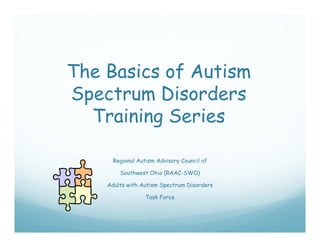Autism 011
- 1. The Basics of Autism Spectrum Disorders Training Series Regional Autism Advisory Council of Southwest Ohio (RAAC-SWO) Adults with Autism Spectrum Disorders Task Force
- 2. Adult Training Series g Modules Module One: Autism Defined, Autism Prevalence and Primary Characteristics Module Two: Physical Characteristics of Autism Module Three: Cognition and Learning in Autism Module Four: Autism and Sensory Differences Module Five: Communication and Autism
- 3. Adult Training Series Modules Module Six: Behavior Challenges and Autism Module Seven: Understanding Behavior in Persons with Autism A tis Module Eight: Functional Behavior Assessment Module Nine: Autism and Leisure Skills to Teach Module Ten: Special Issues of Adolescence and Adulthood Module Eleven: Safety and Autism
- 4. Safety Emergencies: g Because people with ASD can look like everyone else, police and other emergency responders may expect answers to questions that the person is not able to give (for example, giving their name). Some behaviors can be misunderstood (for example, reaching t t hi to touch th officerŌĆÖs b d ) h the ffi ŌĆÖ badge).
- 5. Safety Emergencies: Because people with ASD may have low muscle tone tone, emergency responders should never restrain the person by placing on his/her stomach. This type of restraint has caused death death.
- 6. Safety Dangerous situations: The person may be drawn to materials such as matches and other dangerous items. Wandering off may be a problem. The person may not know how to move around in traffic, such as safely crossing the street. The person may not understand the danger of going off with a stranger.
- 7. Big Idea A person with ASD may not recognize a dangerous situation.
- 8. Safety Strategies Get to know the neighbors. Get to know nearby public safety agencies, police, fire department, and other emergency responders. Consider notifying them that a person with ASD lives in the home including where they sleep and other special needs. If st ff is in th c mmunit with s m n with staff the community ith someone ith ASD, they should carry/wear identification.
- 9. Safety Strategies Identification The person with ASD should carry identification at all times. The person should practice showing their p p g identification. The person should wear a medical alert bracelet/Identification bracelet bracelet. Identification information should say that the person may not be able to speak or may be too frightened to answer questions in an f h emergency.
- 10. Safety and ASD: Strategies t Home St t i at H At home, door alarms may be helpful to make sure the person doesnŌĆÖt leave the house without your knowledge. If the person with ASD has dietary restrictions, refrigerator locks and cabinet locks may be needed. y (Special permission is necessary for this.) Removable stove knobs may be helpful if the person with ASD isnŌĆÖt aware of the danger of burning g g themselves. Cleaning supplies and other dangerous products may need to be locked up. p
- 11. Safety and ASD: y In the Community Autism decals for car windows are available to make sure that in case of an emergency, responders know that there is a passenger with ASD in the vehicle. (contact www autismcincy org) www.autismcincy.org). Many people with ASD are attracted to water. Swimming lessons are helpful to make sure the person is water safe.
- 12. Behavior and Safety When possible, be prepared for situations that p , p p f could lead to behavior difficulties. Know the early signs of a problem behavior. y g f p m Have a plan for when problems occur. Get to know the people who work in the places you go to frequently in the community so they can be helpful in an emergency. n
- 13. Big Idea Get to know the warning signs of a behavior problem so that little problems do not become big ones ones.












